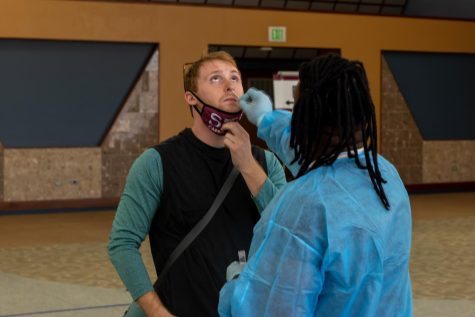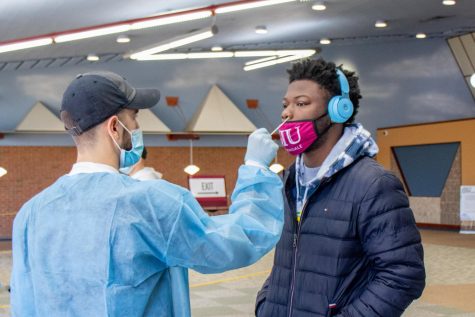“If not now, then when?” The Great Resignation affects the local and national community
“If not now, then when?” The Great Resignation affects the local and national community
The wave of resignations which has swept the country since the beginning of the COVID-19 pandemic has impacted the local, state and national economy in the U.S. as young and old employees seek better working conditions and retire from the workforce altogether.
The event has been dubbed “The Great Resignation” by economists, according to a segment done on the topic by 60 Minutes on CBS on January 9. The event began in early 2020, when COVID-19 regulations were introduced to businesses and the general public.
The labor shortage has not impacted the availability of educators at Southern Illinois University Carbondale (SIU) since the start of the pandemic, Meera Komarraju, the provost and vice chancellor for academic affairs, said.
Advertisement
“When we set our budgets for the academic year, we set a certain amount aside to provide us with some flexibility,” Komarraju said. “That way if we need to hire someone to fill a role throughout the year we always have some wiggle room.”
Komarraju said the process of deciding how many teachers will need to be budgeted on the payroll begins with registration for fall classes during the spring semester.
“We keep an eye on what classes and programs are being applied to by students and we decide whether to adjust the number of instructors on staff for the coming year based on what classes students are applying to,” Komarraju said.
Komarraju said SIU is not facing any staff shortage issues for instructor positions. She said this year’s increase in freshman enrollment provided the resources necessary to maintain adequate teaching staff numbers. She did not have any knowledge of staffing shortages in auxiliary staff.
The U.S. Supreme Court recently struck down U.S. President Joe Biden’s Occupational Safety and Health Administration (OSHA) vaccine-or-test mandate for private businesses. It forced employees to either receive a COVID-19 vaccination regimen or receive a weekly test for the virus as a condition of employment. Public workers and healthcare workers are still required to receive COVID-19 vaccinations and a booster vaccine.
Governor J.B. Pritzker extended a similar mandate in September 2021, bringing SIU to institute the policy on students upon returning to campus for the spring semester. To aid in the testing and vaccination needs of the school, clinics have been coordinated with the Illinois Department of Public Health (IDPH) and Test Directly, a laboratory company which provides access to sample testing, to provide the services to students and faculty.
David Boedeker, the liaison officer for the IDPH, said sometimes inaccurate expectations and staffing shortages can make healthcare difficult to manage efficiently.
Advertisement*
“In early October last year, we had a clinic where we had to take the time to get all the testing equipment and personal protection equipment (PPE) set out and organized,” Boedeker said. “We struggled for two and a half hours to get everything together and brought in two extra people because we expected a high demand, but when the time came for the clinic we only had about ten people the entire time we were there.”
These clinics are allocated staff based on the expected need of the population they will be serving, Boedeker said. Sometimes this results in overestimations, like the October clinic, but sometimes underestimations will hinder efforts, as demonstrated by staffing issues which took place on January 19.
“We had one medical assistant (MA) working the administrative stuff, but then we had a full house by 11:30 a.m. with only one MA doing the work,” Boedeker said. “We called in a second nurse and that helped a little, but we made no progress since people kept coming in.”
For these situations, a reaction force is typically held in reserve for emergency staffing needs, Boedeker said. The reaction force was called in this case and, while it took them a short time to get acquainted with the hectic situation, the force managed to shorten wait times from two hours to 30 minutes by the end of the clinic.
“Several people walked out due to the wait times,” Boedeker said. “They were able to come back later or the next day if they left. It was chaotic, but it ended on a good note.”
Boedeker said temporary workers are often used for these clinics and the goal is to provide more comfortable wait times and circumstances for clinics in the future. While the medical field is in need of additional workers, Boedeker and the IDPH are working to coordinate their current resources to combat the ongoing pandemic and provide vaccines and testing to as many people as possible.
The Economic Policy Institute uses a metric called the Jobs and Labor Turnover Survey (JOLTS) to determine the health of the labor market. This metric accounts for job openings each month, hirings, layoffs, staff quitting and other labor separations like deaths or injuries.
Hesitancy over the job market induced a sharp drop in the number of resignations at the start of the COVID-19 pandemic in January 2020, according to the JOLTS statistics. This trend reversed and met pre-pandemic resignations by July 2020. The trend stabilized for approximately six months before rising to nearly 150% of the number of resignations experienced before the pandemic.
Karin Kimbrough, chief economist at LinkedIn, a popular job matching website, said in her 60 Minutes interview, “People have been living to work for a long time, and I think the pandemic has brought that moment of reflection for everyone.”
Not all sectors of the economy are as affected by current labor shortages, but the retail and hospitality sectors have been particularly affected, Kimbrough said. She said the demographics mostly contributing to the glut of resignations comes from baby boomers retiring early and young adults, particularly women, in their teens and early 20s.
“Americans are burnt out,” Kimbaugh said. “I like to think of it as a ‘take this job and shove it,’ measure. It’s a sign of people saying, ‘you know, I don’t need this.’”
Approximately 6% of all retail positions in the U.S. are open as well as more than 8% of the healthcare field and nearly 9% of restaurant and hotel jobs, according to LinkedIn data. The same data cites 4.4% of jobs in the education sector are available.
“We can see what sectors people are quitting, it’s retail sectors and hospitality sectors,” Kimbaugh said. “People are thinking ‘What do I want to do? What makes my heart sing?’ and people are asking, ‘If not now, then when?’”
Staff reporter William Box can be reached at [email protected] or on Twitter at @William17455137. To stay up to date with all your southern Illinois news, follow the Daily Egyptian on Facebook and Twitter.
Advertisement













